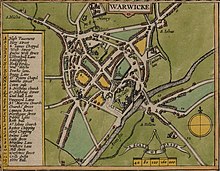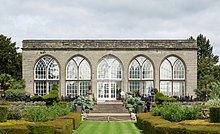Warwick Castle
During the Hundred Years War, the facade opposite the town was refortified, resulting in one of the most recognisable examples of 14th-century military architecture.
Warwick Castle was then sold to Nick Leslau's investment firm, Prestbury Group, under a sale and leaseback agreement.
[4] The lands he was given included Kenilworth – a castle of comparable size, cost, and importance,[5] founded by Clinton[6] – which is about 8 kilometres (5 mi) to the north.
Though the motte to the south-west of the present castle is now called "Ethelfleda's Mound" ('Ethelfleda' being an alternative form of Æthelflæd), it is in fact part of the later Norman fortifications, and not of Anglo-Saxon origin.
[9] After the Norman conquest of England, William the Conqueror established a motte-and-bailey castle at Warwick in 1068 to maintain control of the Midlands as he advanced northwards.
William II appointed Henry de Beaumont, the son of a powerful Norman family, as constable of the castle.
[3][13] According to the Gesta Regis Stephani, a 12th-century historical text, Roger de Beaumont died upon hearing the news that his wife had handed over the castle.
[14] King Henry II later returned the castle to the Earls of Warwick, as they had been supporters of his mother, Empress Matilda, in The Anarchy of 1135–1154.
[16] During the Barons' Rebellion of 1173–74, the Earl of Warwick remained loyal to King Henry II, and the castle was used to store provisions.
Warwick Castle then passed from Neville to his son-in-law, George Plantagenet, 1st Duke of Clarence (brother of King Edward IV).
The castle, as well as lands associated with the earldom, was in Crown care from 1478 until 1547, when they were granted to John Dudley with the second creation of the title the Earl of Warwick.
[3] In October 1601 Sir Fulke Greville wrote that "the little stone building there was, mightily in decay, the timber lodgings built thirty years ago for herself (Elizabeth I) all ruinous; ... so as in very short time there will be nothing left but a name of Warwick".
Fulke Greville, who was himself ennobled as Baron Brooke in 1621, spent over £20,000 (£5 million as of 2025) [30] renovating the castle, while occupying a suite of rooms in the Watergate Tower;[31] according to William Dugdale, a 17th-century antiquary, this made it "a place not only of great strength but extraordinary delight, with most pleasant gardens, walks and thickets, such as this part of England can hardly parallel".
[31] Under Robert Greville, 2nd Baron Brooke, Warwick Castle's defences were enhanced from January to May 1642 in preparation for attack during the First English Civil War.
The garden walls were raised, bulwarks – barricades of beams and soil to mount artillery – were constructed and gunpowder and wheels for two cannons were obtained.
Brown simplified the long narrow stretch by sweeping it into a lawn that dropped right to the riverbank, stopped at each end by bold clumps of native trees.
Then he has scooped out a little burrough in the massy walls of the place for his little self[41] and his children, which is hung with paper and printed linnen, and carved chimney-pieces, in the exact manner of Berkley-square or Argyle Buildings.
[45] Canaletto's work on Warwick Castle has been described as "unique in the history of art as a series of views of an English house by a major continental master".
[49] In 1786–88 the local builder William Eboral was commissioned to build the new greenhouse conservatory, with as its principal ornament the Warwick Vase, recently purchased in Rome.
[47] The castle was extensively damaged by a fire that started in the early hours of Sunday, 3 December 1871,[52] in Lady Warwick's apartments above the library,[53] to the east of the Great Hall.
Two children, Eva and Sydney Greville, were snatched from their beds in a room above the dining hall by their nurse and carried to safety through smoke and flames, minutes before the main staircase collapsed.
A local report stated, "One day last week eight American visitors who were staying at one of the principal hotels left somewhat hurriedly in consequence of their being unable to gain admission to the castle".
In July of that year, Warwick Castle was sold again to the Prestbury Group[72] but it continued to be operated by Merlin under a renewable 35-year lease.
The castle's reputation for being haunted is used as a tourist attraction with events such as "Warwick Ghosts Alive", a live-action show telling the story of Fulke Greville's murder.
On certain dates in August, Dragon Slayer evenings were scheduled, with dining, a projection light show, pyrotechnics, fire jousting and live action stunts.
The first creation of the Earldom specifically included the right of inheritance through the female line, so the castle three times had a woman (or girl) as the owner.
[3] Attempts to make profits from the park in the late 18th century included leasing it for grazing, growing wheat, and keeping sheep.
[3] The latest option at the castle is glamping, overnight stays in nicely decorated tents in an area labelled Knight's Village.
[96] In December 2007, George Townley tripped and fell on a low section of the Bear and Clarence Bridge at Warwick Castle into a dry moat beneath.
Merlin Attractions were unanimously found guilty of health and safety laws at Warwick Crown Court, and were ordered to pay £350,000 in fines and costs.


















